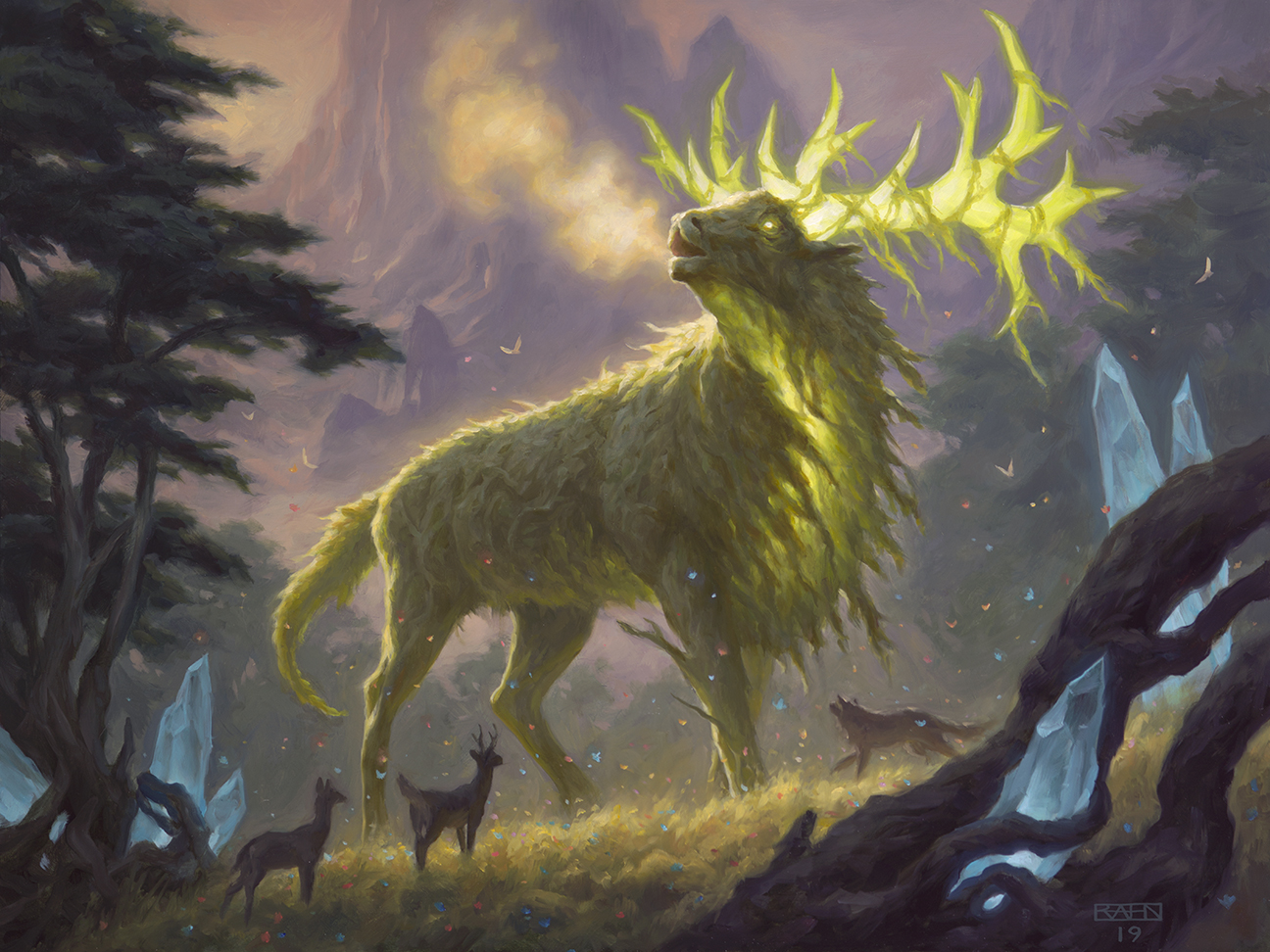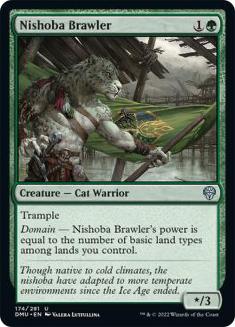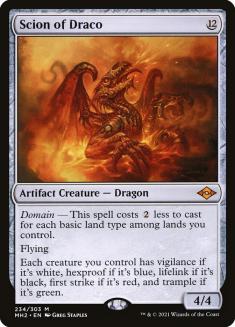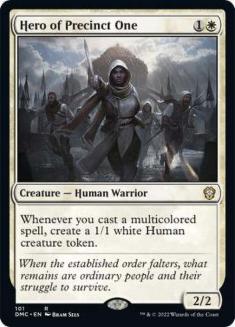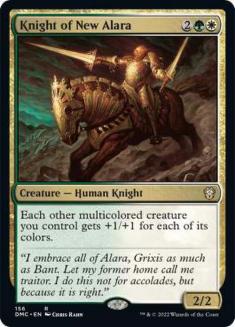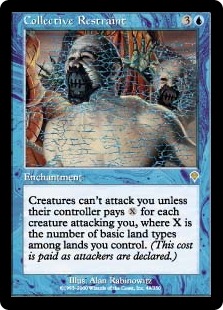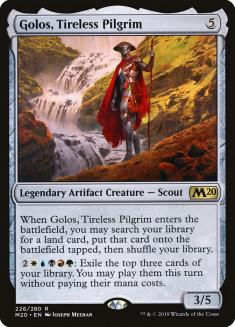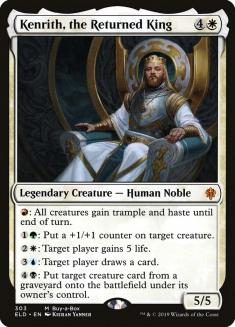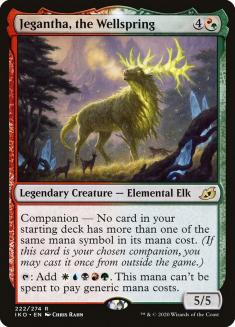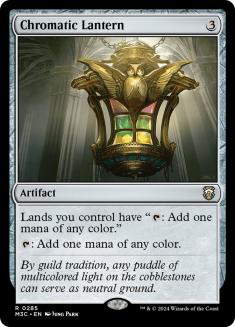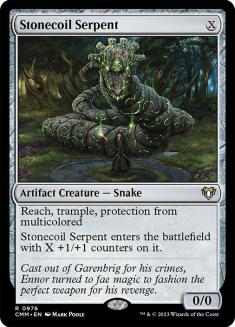With Dominaria United‘s paper release coming up this week, I’ve been playing a lot of Sealed on Magic Arena and making plans to get cards to update my paper Cubes. There’s a lot to like in the set, but personally, I’m most excited about the return of domain as a mechanic. I’ve been casting a lot of Meria’s Outriders and Gaea’s Mights, and just having a blast doing so. Domain’s return is actually very significant for a Twobert project that I’ve been working on.
As you all know, I’m not the biggest fan of Triomes for Cube in general. I’ve found them to be very replaceable additions to the Magic Online (MTGO) Vintage Cube, and they’re not really considerations for most of my designs. However, I can’t deny that there’s a part of me that wants nothing more than to cast Tribal Flames for the full five damage. It’s this desire that motivated me to start working on a Domain Twobert some time ago, which gained a lot from the completion of the Triome cycle with Streets of New Capenna. It was still rough around the edges at that time, but Dominaria United has put the design in a place where I really like what I have.
From Gold Cube to Domain Twobert
Years back, a friend of mine kept a Gold Cube together, which contained only gold cards and mana-fixing lands. I knew that I wanted to have a lot of gold cards when I set out to design a Domain Cube, but you do miss out on a lot of aspects of Magic without any non-gold spells. Not including the aforementioned Tribal Flames would be a huge miss for me, but mana curves also just end up being pretty clunky with the relative dearth of one-mana spells in such an environment. So I wanted something that skewed heavily towards multicolor spells, with significant incentives to be able to produce all five colors of mana, while still facilitating some aggressive/lean strategies.
Here’s my current list for the Domain Twobert. In a lot of ways, the color distribution of this design was inspired by my Artifact Twobert. That Cube pushes the limits on how few nonartifact cards you can include in a Cube to incentivize decks that are heavy on artifacts where colored mana still matters, whereas this design goes even lighter on mono-color spells to push players to value lands very highly and require players to draft a lot of multicolor spells.
There are plenty of drafters out there who don’t need any further incentives to value mana-fixing highly, but the five-color decks that this Cube generates won’t all look like the value piles that players who value mana-fixing above everything else usually draft. Some of those Triomes will power out fast kills with Nishoba Brawler and Scion of Draco, and that’s just a thing of beauty.
Color Distribution
The color distribution of this Cube isn’t fully balanced, with some colors and color pairs offering more desirable options than others, but it does come out pretty close once you account for all the little quirks of the Cube. Not to mention that the idea is that every deck this Cube generates is heavily incentivized to play all five colors anyway. Maybe one or two of those colors are light splashes, if even just for domain, but the point is you’re going to want to draft some Triomes here.
I typically break Cubes down by color to establish how to approach playing a Cube, though that’s not as meaningful of a lens as it usually is here. Instead, I’m going to break things down by categories of how many colors a card is to establish what mono-colored cards and the various shades of gold have to offer to the Draft environment.
Mono-Color
A lot of the idea behind the mono-color cards in this Cube are to offer players some cheap creatures and some cheap removal spells. Part of my vision early on while designing this Cube was that I wanted Hero of Precinct One to be a card that players would happily play, and you can see from that card, as well as the selection of mono-color cards that care about you controlling certain land types, that very few of the mono-color cards featured here do much to curb the appeal of playing all five colors.
I had considered trying to fit more micro-themes into the Cube, but they tended to stand out and (by my estimation) detract from the aesthetic of the Cube more than anything. For example, I had looked at fitting in cards like Young Pyromancer and some cheaper cantrips in blue, but that’s just stuff you can draft anywhere, and I find the spread of mostly domain spells in the mono-color section does a much better job at highlighting the novelty of this environment. I’m also quite fond of Steppe Lynx and Akoum Hellhound here, considering that the five-color focus makes it pretty uncommon to want to trim lands in this Cube, and the lower density of cheap creatures than you typically see in Cubes raises their stock significantly as well.
Two-Color
Similarly to the mono-color section, I looked at offering firmer identities to the two-color pairs, but for the most part the emphasis is still just on offering good gold cards. You do see a slightly higher emphasis on establishing some micro-archetypes in this column, though ultimately this still does take a backseat to the macro gold theme.
Still, Azorius and Dimir offer controlling cards, while Gruul, Rakdos, and Boros offer aggressive options. Izzet gives a taste of spells-matters options, just as Orzhov dips slightly into tokens. Selesnya actually gets one of the most significant signpost cards in the Cube in Knight of New Alara, which pairs very well with the three hybrid Selesnya one drops.
Mostly, you’ll be trying to navigate whether you want to play Five-Color Control or Five-Color Aggro in this Cube, and every color pair offers something for both approaches. Part of the incentive to have a lot of two-color cards was also to juice Niv-Mizzet Reborn specifically.
Three-Color
Three-color cards tend to be much less represented in most Cubes than two-color or really even five-color cards. They’re just a little too difficult to cast unless your Cube is very long on mana-fixing, which made featuring a bunch of three-color cards here appealing.
Enemy combinations are still a bit more spoiled than allied ones when it comes to options here, but there’s some draw to every three-color card featured here. I’m personally quite fond of the Alara Reborn “Blade” cycle, with the way that they curve into Knight of New Alara being a big part of their appeal. Beyond that, they do a lot of work in keeping the mana curve of the Cube down.
A card that I considered for a Jund slot that makes me nostalgic for the old Extended PTQ days is Destructive Flow. I did feature Collective Restraint as a nod to that same era that opens the door for some prison-y (see: miserable) Magic, but Collective Restraint is substantially easier to fight your way out of.
I like the idea of maybe letting Destructive Flow in and out of the Cube for the days when I really want to grief someone, but it’s a little too hateful of a thing for me to endorse for every playgroup. Ultimately, it’s pretty rude to offer heavy incentives to do a certain thing in-game and then massively punish a player for doing so. If you want to destroy lands, you’ll have to settle for Vindicate and Fulminator Mage, which are just the right amount of rude.
Four- and Five-Color
There’s not really a reason to give Omnath, Locus of Creation its own section, and it’s really doing the same thing as any of the five-color cards: getting you to put some lands of every type into your deck. Technically Golos, Tireless Pilgrim and Kenrith, the Returned King let you get by without the full spread, but you’ll want access to all five colors to fully use these cards.
There aren’t a lot of Cubes that let you use the mana that Jegantha, the Wellspring generates quite as much as this one. It’s still a lot of mana to invest into a 5/5, but the payoff can be very real. I’m a big fan of highlighting cards like this that are much more powerful in this specific environment than they normally would be.
I think it’s reasonable to include even more five-color options in the Cube, but these are the biggest payoffs available, and I am still trying to keep the mana curve of the Cube low-ish. Ultimately, I think Leyline Binding adds more to the Cube than stuff like Maelstrom Archangel.
Artifacts
This section is very light, and still, like Scion of Draco and Clearwater Goblet, may as well be classified as five-color. I like having Chromatic Lantern here to offer a little bit of an easy mode for a player who drafted a rougher manabase to cast their spells. It’s one of very few mana accelerants in the Cube and is quite powerful in its own right, but not oppressively so.
Stonecoil Serpent is another card that does some work in lowering the mana curve of the Cube, while also offering a little hate for the powerful gold cards. Again, nothing oppressive, just another card with text similar to Soldier of the Pantheon to give aggressive decks small edges. This also offers an amusing comparison to General Ferrous Rokiric, who is much easier to trigger in this Cube than most, but also much easier to kill.
Lands
There’s nothing fancy here. Fetches, shocks, Triomes, and Field of the Dead. Field of the Dead for the obvious Golos synergies, and mana-fixing because, well, that’s the entire theme of the Cube. I have a general preference for shocklands over the original dual lands for general gameplay purposes, and with there being a bit more incentive to draft a controlling deck than an aggressive on in an environment like this, I like having a little more cost associated with mana-fixing. Control players are more likely to pass shocklands to aggressive players than the original duals while focusing more on Triomes for themselves, which is a small thing that helps with the balance of the environment.
It’s totally reasonable to feature the original duals over the shocklands, especially if you’re most interested in the controlling decks and/or you find the aggressive decks are more successful in your playgroup. Ultimately, this is a fairly minor element of the Cube relative to just making sure players have high access to every land type.
The Domain Event
Whether you’re a multicolor enthusiast or you feel the nostalgia that Gaea’s Might and Tribal Flames bring me, this is a very fun Cube environment that highlights a number of things that we don’t usually see in Cube, and offers fun spins on controlling and aggressive decks alike. I know that a lot of you are much bigger on Triomes broadly than I am, but I’ve been a much bigger fan of them as specific game pieces than generic ones. Give this Cube a try, and you might see my side of it.

